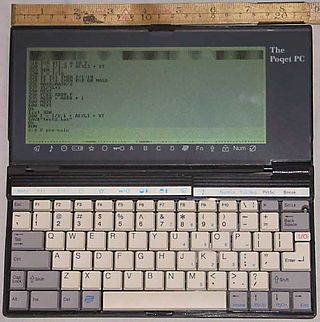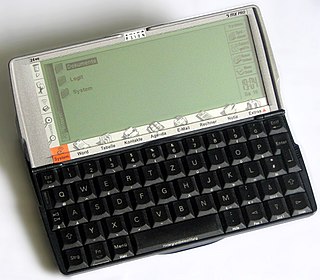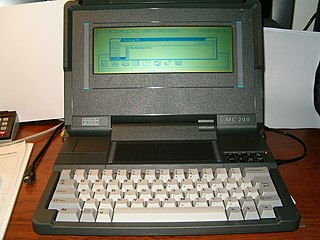
A motherboard is the main printed circuit board (PCB) in general-purpose computers and other expandable systems. It holds and allows communication between many of the crucial electronic components of a system, such as the central processing unit (CPU) and memory, and provides connectors for other peripherals. Unlike a backplane, a motherboard usually contains significant sub-systems, such as the central processor, the chipset's input/output and memory controllers, interface connectors, and other components integrated for general use.

A personal digital assistant (PDA) is a multi-purpose mobile device which functions as a personal information manager. Following a boom in the 1990's and 2000's, PDA's were mostly displaced by the widespread adoption of more highly capable smartphones, in particular those based on iOS and Android in the late 2000's, and thus saw a rapid decline.

Universal Serial Bus (USB) is an industry standard that allows data exchange and delivery of power between many types of electronics. It specifies its architecture, in particular its physical interface, and communication protocols for data transfer and power delivery to and from hosts, such as personal computers, to and from peripheral devices, e.g. displays, keyboards, and mass storage devices, and to and from intermediate hubs, which multiply the number of a host's ports.
Psion Organiser was the brand name of a range of pocket computers developed by the British company Psion in the 1980s. The Organiser I and Organiser II had a characteristic hard plastic sliding cover protecting a 6×6 keypad instead of a computer keyboard, with letters arranged alphabetically.

The Poqet PC is a line of palmtop PCs introduced in 1989 by Poqet Computer Corporation. The eponymous first model was the first IBM PC–compatible palmtop computer capable of running MS-DOS at CGA resolutions. The Poqet PC is powered by two AA batteries. Through the use of aggressive power management, which includes stopping the CPU between keystrokes, the batteries are able to power the computer for anywhere between a couple of weeks and a couple of months, depending on usage. The computer also uses an "instant on" feature, such that after powering it down, it can be used again immediately without having to go through a full booting sequence. The Poqet PC is comparable to the HP 95LX/HP 100LX/HP 200LX and the Atari Portfolio handheld computers. The computer originally sold for US$2,000; it was discontinued after Fujitsu Ltd. bought Poqet Computer Corp.

A laptop computer or notebook computer, also known as a laptop or notebook, is a small, portable personal computer (PC). Laptops typically have a clamshell form factor with a flat-panel screen on the inside of the upper lid and an alphanumeric keyboard and pointing device on the inside of the lower lid. Most of the computer's internal hardware is fitted inside the lower lid enclosure under the keyboard, although many modern laptops have a built-in webcam at the top of the screen, and some even feature a touchscreen display. In most cases, unlike tablet computers which run on mobile operating systems, laptops tend to run on desktop operating systems, which were originally developed for desktop computers.

The Apple IIc is a personal computer introduced by Apple Inc. shortly after the launch of the original Macintosh in 1984. It is essentially a compact and portable version of the Apple IIe. The IIc has a built-in floppy disk drive and a keyboard, and was often sold with its matching monitor. The c in the name stands for compact, referring to the fact it is a complete Apple II setup in a smaller notebook-sized housing. It is compatible with a wide range of Apple II software and peripherals.

The Psion Series 5 was a personal digital assistant (PDA) from Psion. It came in two main variants, the Series 5 and the Series 5mx (1999), the latter having a faster processor, clearer liquid crystal display (LCD), and updated software. There was also a rare Series 5mx Pro, which differed only in having the operating system (OS) loaded into random-access memory (RAM) and hence upgradeable. Ericsson marketed a version of the Series 5mx renamed as MC218.

The Psion Series 3 range of personal digital assistants were made by Psion PLC. The four main variants are the Psion Series 3 (1991), the Psion Series 3a (1993), the Psion Series 3c (1996), and the Psion Series 3mx (1998), all sized 165 by 85 by 22 millimetres. Further, a Psion Series 3a variant with factory installed software for the Russian language was called a Psion Series 3aR, and Acorn Computers sold renamed versions of the Psion Series 3 and 3a marketed as the Acorn Pocket Book and Acorn Pocket Book II.
The Sony U series of subnotebook computers refers to two series of Sony products the PCG-U and the VGN-U. The later VGN-U were, at their release, the smallest independent computers running Windows XP and the most powerful high-end subnotebooks at the time. The VGN-U50 and VGN-U70P models are roughly the size of two DVD cases stacked on top of each other.
The Psion Series 7 is a subnotebook computer from Psion that was released in 2000. In size it is fairly original: larger than a palmtop or handheld machine, but smaller than a laptop computer. It was the first and last of the Psion series to have a full color electronic visual display. It has a leather-bound clamshell design, with a touch-sensitive, Video Graphics Array (VGA) resolution liquid-crystal display (LCD) and QWERTY computer keyboard. Internally it has a 132.71 MHz StrongARM SA-1100 processor, 16 megabyte (MB) of random-access memory (RAM) and 16 MB of internal read-only memory (ROM).
Microsoft Gadgets are lightweight single-purpose applications, or software widgets, that can sit on a Microsoft Windows user's computer desktop, or are hosted on a web page. According to Microsoft, it will be possible for the different types of gadgets to run on different environments without modification, but this is currently not the case.
Programmable calculators are calculators that can automatically carry out a sequence of operations under control of a stored program. Most are Turing complete, and, as such, are theoretically general-purpose computers. However, their user interfaces and programming environments are specifically tailored to make performing small-scale numerical computations convenient, rather than general-purpose use.

The PowerBook 100 is a notebook-sized laptop computer designed and manufactured by Sony for Apple Computer and introduced on October 21, 1991, at the COMDEX computer expo in Las Vegas, Nevada. Priced at US$2,500 with external floppy drive, the PowerBook 100 was the low-end model of the first three simultaneously released PowerBooks. Its CPU and overall speed closely resembled those of its predecessor, the Macintosh Portable. It had a Motorola 68000 processor at 16 MHz, 2-8 megabytes (MB) of RAM, a 9-inch (23 cm) monochrome backlit liquid-crystal display (LCD) with 640 × 400 pixel resolution, and the System 7.0.1 operating system. It did not have a built-in floppy disk drive and was noted for its unique compact design that placed a trackball pointing device in front of the keyboard for ease of use.

The Palm m100 series consists of four Palm OS based personal digital assistants titled m100, m105, m125, and m130. These models were intended to be "entry-level" PDAs, and therefore their cases were built from cheaper materials. Most notably, the covers of the LCD screens and the digitizers were plastic rather than glass, and the screens were smaller than the more expensive Palm devices on sale at the time.

The ASUS Eee PC is a netbook computer line from Asus, and a part of the ASUS Eee product family. At the time of its introduction in late 2007, it was noted for its combination of a lightweight, Linux-based operating system, solid-state drive (SSD), and relatively low cost. Newer models added the options of Microsoft Windows operating system and rotating media hard disk drives (HDD), and initially retailed for up to 500 euros.

The history of laptops describes the efforts, begun in the 1970s, to build small, portable Personal Computers that combine the components, inputs, outputs and capabilities of a Desktop Computer in a small chassis.
The Dell Inspiron Mini Series is a line of subnotebook/netbook computers designed by Dell. The series was introduced in September 2008 amidst the growing popularity of low-cost netbook computers introduced by competitors.

The Psion MC series is a line of laptop computers made by Psion PLC and launched in 1989.

The Palm Top PC 110 is a handheld personal computer that was developed jointly by IBM's Japanese subsidiary and Ricoh. It was released exclusively in Japan in September 1995. It used the Intel 80486SX microprocessor and was available in three different configurations. It used a Japanese keyboard, could be used in a docking station, and had a modem connection. During the development phase, the size was decreased. After the release, it was received positively for the number of features, but negatively for the small keyboard.














